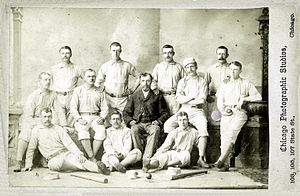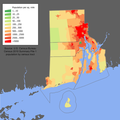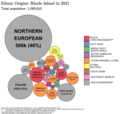Portal:Rhode Island
The Rhode Island Portal Rhode Island (/ˌroʊd-/ ROHD) is a state in the New England region of the Northeastern United States. It borders Connecticut to its west; Massachusetts to its north and east; and the Atlantic Ocean to its south via Rhode Island Sound and Block Island Sound; and shares a small maritime border with New York, east of Long Island. Rhode Island is the smallest U.S. state by area and the seventh-least populous, with slightly fewer than 1.1 million residents as of 2020; but it has grown at every decennial count since 1790 and is the second-most densely populated state, after New Jersey. The state takes its name from the eponymous island, though nearly all its land area is on the mainland. Providence is its capital and most populous city. Native Americans lived around Narragansett Bay for thousands of years before English settlers began arriving in the early 17th century. Rhode Island was unique among the Thirteen British Colonies in having been founded by a refugee, Roger Williams, who fled religious persecution in the Massachusetts Bay Colony to establish a haven for religious liberty. He founded Providence in 1636 on land purchased from local tribes, creating the first settlement in North America with an explicitly secular government. The Colony of Rhode Island and Providence Plantations subsequently became a destination for religious and political dissenters and social outcasts, earning it the moniker "Rogue's Island". Rhode Island was the first colony to call for a Continental Congress, in 1774, and the first to renounce its allegiance to the British Crown, on May 4, 1776. After the American Revolution, during which it was heavily occupied and contested, Rhode Island became the fourth state to ratify the Articles of Confederation, on February 9, 1778. Because its citizens favored a weaker central government, it boycotted the 1787 convention that had drafted the United States Constitution, which it initially refused to ratify; it finally ratified it on May 29, 1790, the last of the original 13 states to do so. The state was officially named the State of Rhode Island and Providence Plantations since the colonial era but came to be commonly known as "Rhode Island". In November 2020, the state's voters approved an amendment to the state constitution formally dropping "and Providence Plantations" from its full name. Its official nickname is the "Ocean State", a reference to its 400 mi (640 km) of coastline and the large bays and inlets that make up about 14% of its area. (Full article...) Entries here consist of Good and Featured articles, which meet a core set of high editorial standards.
 The Providence Grays were a Major League Baseball franchise based in Providence, Rhode Island from 1878 to 1885. During the team's eight seasons in the National League (NL), which then comprised eight teams, they finished third place or higher in the final standings seven times, and won the league championship in both 1879 and 1884. Providence played their home games at the Messer Street Grounds, which was located in the Olneyville neighborhood of Providence. The Grays were officially organized on January 16, 1878 by Benjamin Douglas, who became the team's general manager. Henry Root was hired as the team president‚ and Tom Carey was initially hired to be the on-field captain, whose duties were similar to the modern-day manager. On January 21, 1878, Providence applied for membership in the NL, and was officially approved on February 6. On April 10, Root took over ownership of the team, fired Douglas for incompetence and insubordination, and hired Tom York to replace Carey as captain. Providence was successful in signing several star players for their inaugural season: Paul Hines had played the previous four seasons with the Chicago White Stockings; Tom Carey was signed after the Hartford Dark Blues folded; Doug Allison was the catcher for the 1869 Cincinnati Red Stockings, who had an 84-game winning streak from 1869 to 1870; and John Montgomery Ward, who was playing his first season in the major leagues. Ward had a win–loss record of 22–13 and Hines led the league in home runs, runs batted in (RBIs), and batting average as the Grays finished in third place among the six teams in the NL for the 1878 season, with a record of 33 wins, 27 losses, and 2 ties. The Grays won the NL championship in 1879, placing first among the league's eight teams with Ward winning 47 games as their starting pitcher, and the leadership of George Wright, who played second base and also managed. The team had a strong hitting line-up with Hines' league leading .357 batting average, as well as new additions Jim O'Rourke and Joe Start, who both had batting averages over .300. William Edward White, a Brown University player who played one game for the Grays on June 21, 1879, may have been the first African-American to play at the major league level; according to Peter Morris of the Society for American Baseball Research, the evidence for White is strong, but not conclusive. If this claim is true, then White pre-dated both Moses Fleetwood Walker and his brother Weldy Walker, who both played for the 1884 Toledo Blue Stockings of the American Association (AA). In 1880, the Grays finished in second place among the eight NL teams, with Ward winning 39 games. On June 17 of that year, Ward pitched the second perfect game in major league history. (Full article...)Selected article -
The First Baptist Meetinghouse, also known as the First Baptist Church in America is the oldest Baptist church congregation in the United States. The Church was founded in 1638 by Roger Williams in Providence, Rhode Island. The present church building was erected between 1774 and 1775 and held its first meetings in May 1775. It is located at 75 North Main Street in Providence's College Hill neighborhood. It was designated a National Historic Landmark in 1960. It is affiliated with the American Baptist Churches USA. (Full article...)
Did you know?
Related portalsSelected picture Waterplace Park is an urban park situated in downtown Providence, Rhode Island, finished in 1994. It is connected to 3/4 miles of cobblestone-paved pedestrian walkways along the waterfront known as Riverwalk. General imagesThe following are images from various Rhode Island-related articles on Wikipedia.
TopicsSelected panoramaThe skyline of Providence, Rhode Island
Quality content
Featured articlesFeatured listsGood articles
Featured portalsGood article nomineesFormer featured articlesFormer featured listsFormer good articlesSubcategoriesRelated WikiProjectsThings you can do
Associated WikimediaThe following Wikimedia Foundation sister projects provide more on this subject:
Discover Wikipedia using portals |


























































